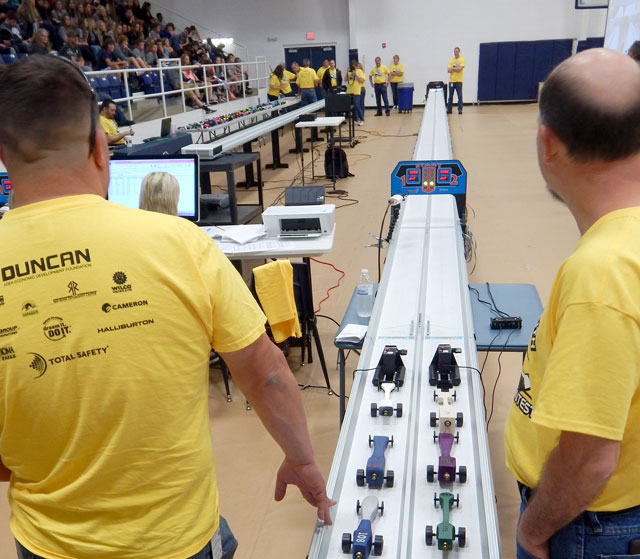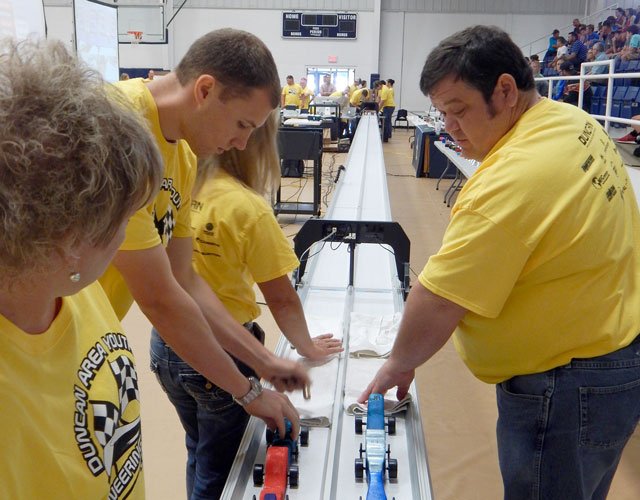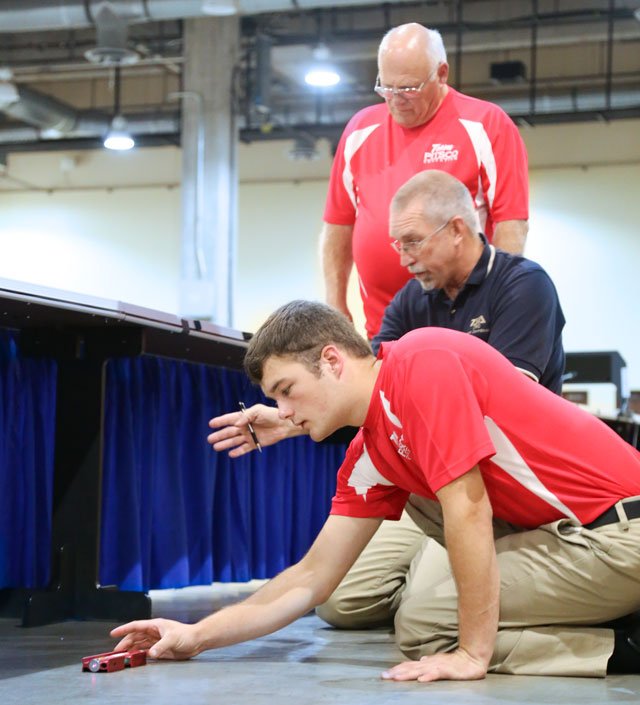For 25 years, Pitsco Technical Support Steve Snider ran CO2 dragster races for national and regional events. He was always precise, efficient, and good at teaching others. This winter, I had the opportunity to sit down and talk with Steve about what he’d learned over the years. Little did we know then that he was very ill, and he took leave soon after. He passed away March 16 – a great loss to the Pitsco family.
We decided to share this story because Steve valued being of service to others, and his legacy and shared knowledge continue to do just that. Steve's input should help both the teacher who runs a race once or twice a year and the most experienced racer.
Top Tips
- Be sure to plan your space before setting up the track.
- Make sure your track surface is level.
- Tie the monofilament line tight and restring it every day.
- Train your race staff to know the racing process for an efficient and safe event.
- Use the deceleration towels as directed – other items don’t work well.
- Contact Customer Support at 800-358-4983 or [email protected] for help if needed.
Other things to keep in mind . . .
Location, Location, Location
First things first: you need a good spot to run the race. Whether on an elevated track – such as our FasTrak – or on the floor, either works as long as you have enough smooth space. A typical track is 80 feet long and must be smooth and even.

“Gym floors are good,” Steve said. “If you use a concrete floor, you may not realize that there are waves in the floor that you cannot see.”
Before setting up the track, consider where the start and finish gates will be and think out the process. Determine the type of launcher and timers you'll use. Identify where the electrical outlets are located. If you're using an electronic launcher, it’s ideal to have the start end near an outlet so you don’t have to run an extension cord the length of the track, adding a trip hazard.
Another tip to plan your space better is to get a long measuring tape or a Rolatape to measure and map out the area before you start setting up – don’t guess.
Getting It Tight
The monofilament line that runs from one end of the track to the other is what keeps the cars running in a straight line, but Steve pointed out that this material has some stretch to it. So, when attaching the line:
- On one end, tie a loop that is 1" to 1-1/2" long using a tight square knot and then cut off the excess string from the knot.
- Attach the loop to the post at the start end and run it down the track.
- Cut it off so it is about 18" short of reaching the end of the track.
- Tie another 1" to 1-1/2" loop with a square knot and pull the line to the post at the finish end.
- Repeat this process for the second lane.
“You want this line to be taut,” he said. “You don’t want it so tight that you can play a tune on it, but you don’t want it loose.”
When you run a lot of races, the line stretches – but wait to change it until the end of the day or just before the finals. If there’s a problem with one line, replace both lines to keep the races fair. Replace the line if it has been stretched on the track overnight.
One more tip: Steve said that, because of the loop at the end of the line, 30-pound line runs through the car screw eyes easier than 50-pound line.
Running the Race
To run a race quickly and efficiently – an important thing to teachers with limited time – you need to prepare the race staff with some key tips.
On a regular track, you can prep up to five cars at a time. Steve insisted the best way to save time is to turn the cars upside down when staging them.
“Your finish line team has to work with you,” Steve said. “They have to take their line off so that loosens up your line so you can run the loop through each car. Then we flip the cars over carefully and insert cartridges. We hold our line on and the finish team retightens the line on their end. This prevents damage to the cars.”

The deceleration towels, which are folded and placed in finish end lanes, protect the cars from damage.
“Those towels are in there for a reason. You want to decelerate that car without killing it,” Steve said. “Folding towels as directed in the instructions is key. We have tried multiple ways and the towels seem to work the best, but you want them to be trifolded. Trifold each one lengthwise and leave it in the roadbed, and then you take the end and flip it under on the side where the cars come in at the finish.”
The finish team needs to keep a hand on the back of each towel when a car comes in. If not, cars could hit the lane post and break – which would make some very unhappy students. Speaking as someone who worked on a finish line, I can say that it doesn’t hurt when the cars hit the towel.
Another key to a safe race is to keep all observers back five to six feet from the side of the track in case a piece comes off a car. No one other than the crew should be behind the finish end. This can be difficult when students become excited about the race, but it’s a big part of running a fun and safe event you can do year after year!
Tricks to the FasTrak
For those with a FasTrak Elevated Racetrack, Steve knew helpful tips and answers to common questions about it.
For the older FasTrak that uses tabs to join the panels, Steve said to watch that the track doesn’t start to warp or become unlevel in a way that causes the finish end to be higher than the start end – that will hinder a proper race. He added that this track is easy to level with wood shims, catalogs, or books, though a laser level is handy too.

This version of the track has two points of contact per leg support, which makes it simple to level. The new FasTrak II takes a bit more.
“Now there’s a cross section – we have a four-legged pedestal,” Steve explained. “This was to give the track more stability, but it also makes it more difficult to level because now you don’t just have two points to level, you have four points.”
“Visually, it should be very apparent if the track is level, but you’ll never get it perfect,” he added.
The best tip Steve had for the FasTrak II concerns the three screws that hold one panel to another. First, put in all the center screws for the entire length of the track, and then tighten the side screws.
“What I've found is that this brings the track into alignment and the side screws go in very well,” Steve explained.
Because each track has unique characteristics, Steve recommended always using the track pieces in the same order. To do this, set up the track so it is level and go under the track to label with a permanent marker each joint all the way down the track. Then, follow these to consistently set up the track in the future.
And does your track have slight gaps between each panel of the aluminum sections on the outside edges? It’s OK!
“This gap is preplanned – it’s not an accident or a defect in the track. We’re more interested in the roadbed part of the track fitting flush.”
If you don’t like the gaps for any reason, Steve said they can be covered with heavy tape; however, if the track line is properly tightened, there should be no need to worry about cars catching on these gaps.
Still have questions about how to run a race or racing equipment? Call our Customer Support at 800-358-4983 or [email protected]. Happy racing!
